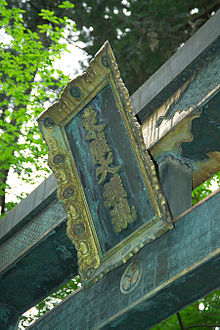- Gongen
-
 Nikkō Tōshō-gū enshrines Tokugawa Ieyasu under the posthumous name of Tōshō Daigongen
Nikkō Tōshō-gū enshrines Tokugawa Ieyasu under the posthumous name of Tōshō Daigongen Main article: Honji suijaku
Main article: Honji suijakuDuring the era of shinbutsu shūgō (religious syncretism of kami and buddhas), in Japan a ( gongen (権現) was believed to be a Japanese kami which was really just the local manifestation of an Indian buddha, an entity who had come to guide the Japanese to salvation.[1][2] The words gonge (権化) and kegen (化現) are synonyms of gongen.[3] Gongen shinkō (権現信仰 lit. gongen belief) is the belief in the existence of gongen.[3]
The gongen concept is the cornerstone of the honji suijaku theory, according to which Indian Buddhist deities choose to appear to the Japanese as native kami in order to save them.
Contents
History
 Tablet on torii at Nikkō Tōshō-gū reads "Tōshō Daigongen" (calligraphy by Emperor Go-Mizunoo)
Tablet on torii at Nikkō Tōshō-gū reads "Tōshō Daigongen" (calligraphy by Emperor Go-Mizunoo)
It is sometimes assumed that the word gongen derives from Tokugawa Ieyasu's posthumous name (Tōshō Daigongen). The term however was created and started being used in the middle of the Heian period in an effort to harmonize Buddhism and Shinto in what is called shinbutsu shūgō, or "syncretism of kami and buddhas".[2] At that time, the assumption that Japanese kami and buddhas were essentially the same evolved into a theory called honji suijaku (本地垂迹) which held that kami were manifestations (avatars) of buddhas, bodhisattvas and other Buddhist deities.[2] The theory gradually spread around the country and the concept of gongen, a dual entity composed of a buddha and a kami, evolved. Under the influence of Tendai Buddhism and of Shugendō, the gongen concept was adapted to religious beliefs tied to Mount Iwaki, a volcano, so that female kami Kuniyasutamahime became associated with Jūichimen Kannon Bosatsu (eleven-faced Kannon), kami Ōkuninushi with Yakushi Nyorai, and Kunitokotachi no Mikoto with Amida Nyorai.[4]
The title gongen started being attached to the names of kami and shrines were built within the premises of large Buddhist temples to enshrine their tutelary kami.[2] During the Japanese Middle Ages, shrines started being called with the name gongen to uderline their ties to Buddhism.[3] For example, in Eastern Japan there are still many Hakusan shrines where the shrine itself is called either gongen or jinja.[3] Because it represents the application of Buddhist terminology to Shinto kami, the use of the term was legally abolished by the Meiji government with the Shinto and Buddhism Separation Order (神仏判然令 Shin-butsu Hanzenrei), and shrines began to be called jinja.[3]
Gongen of Japan
- Izuna Gongen (飯網の権現) — Also called Izuna Myōjin and enshrined in Izuna Shrine in Nagano, it is similar to a tengu.[5]
- Izusan Gongen (伊豆山権現) or Hashiri-yu Gongen (走湯権現) — It's the spirit of a hot spring on Izusan, a hill in Shizuoka Prefecture[6]
- Kumano Gongen (熊野権現) — Also known as Kumano Sanzan (熊野三山).[7][8] The kami enshrined in the three Kumano Sanzan Grand Shrines are the three Kumano mountains: Hongū, Shingū, and Nachi.[7]
- Seiryū Gongen (清滝権現) — Enshrined in Jingo-ji in Takao as tutelary kami of the Shingon sect by Kūkai.[9]
- Tōshō Daigongen — One of the most famous examples of gongen is the already mentioned Tōshō Daigongen (東照大権現), or Tokugawa Ieyasu, posthumously enshrined in so-called Tōshō-gū shrines present all over Japan. The original one is Nikkō Tōshō-gū in Nikkō.
- Zaō Gongen (蔵王権現) or Kongō Zaō Bosatsu (金剛蔵王菩薩) — A deity worshiped only by Japan's Shugendō sect.[10]
Gongen-zukuri
Main article: Ishi-no-ma-zukuriGongen-zukuri (権現造) is the name of a complex Shinto shrine structure in which the haiden, or worship hall, and the honden, or main sanctuary, are interconnected under the same roof in the shape of an H.[11][12] One of the oldest examples of gongen-zukuri is Kitano Tenmangū in Kyoto.[11] The name comes from Nikkō Tōshō-gū in Nikkō because, as we have seen, it enshrines the Tōshō Daigongen and adopts this structure.[13]
See also
- The Glossary of Shinto for an explanation of terms concerning Japanese Shinto, Shinto art, and Shinto shrine architecture.
Notes
- ^ Encyclopedia of Shinto, Gongen accessed on October 5, 2008
- ^ a b c d Tamura (2000:87)
- ^ a b c d e Encyclopedia of Shinto, Gongen shinkō, accessed on October 5, 2008
- ^ Breen, Teeuwen (2000:194)
- ^ Encyclopedia of Shinto, Izuna Gongen, accessed on October 6, 2008
- ^ Jaanus, Izusan Gongen, accessed on October 6, 2008.
- ^ a b Encyclopedia of Shinto, Kumano Shinkō, accessed on October 6, 2008
- ^ Kumano Sanzan, World Heritage Registration Association, accessed on October 13, 2008
- ^ Jaanus, Seiryū Gongen, accessed on October 6, 2008
- ^ Encyclopedia of Shinto, Zaō Gongen, accessed on October 6, 2008
- ^ a b Encyclopedia of Shinto, Gongen-zukuri accessed on October 5, 2008
- ^ For details about these terms, see the article Shinto shrine.
- ^ Jaanus, Gongen-zukuri, accessed on October 5, 2008
References
- Tamura, Yoshiro (2000). Japanese Buddhism — A Cultural History (First Edition ed.). Tokyo: Kosei Publishing Company. pp. 232 pages. ISBN 4-333-01684-3.
- Breen, John, Mark Teeuwen (editors) (July 2000). Shinto in History: Ways of the Kami. Honolulu: University of Hawaii Press. ISBN 978-0824823634. OCLC 43487317.
Categories:- Shinto
- Japanese religions terms
- Buddhism in Japan
- Shinbutsu shūgō
Wikimedia Foundation. 2010.

